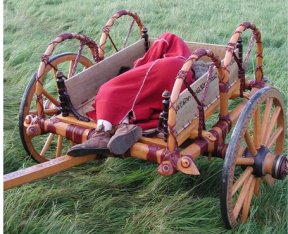As part of my course at Bridport I gave a talk on the chariot burials at Wetwang in Yorkshire. The excavations of 1984 and 2001 allowed archaeologists to reconstruct an Iron Age chariot and tackle some of the practical engineering problems of how to make one work as an instrument of war and part of burial ritual. The most remarkable discovery is that the fighting platform was free to move by suspending it from the side arches using straps, as can been seen in this photo. Thus the standing warrior, pulled by two ponies driven by a seated companion, would not be thrown off going over rough ground and thus deliver the spear into an enemy.
One grave was that of a woman, c.35-45. This individual was reconstructed and found to have a facial disfigurement. She also had a dislocated shoulder which had not been reset in life. Are the two connected, being on the same side - an accident? Or was this a result of disease or from birth?
The 1984 site was only saved from total destruction by the quarry manager Mr Mick Ward, who stopped the machines when he saw one of the metal tyres sticking out of the side of a cut. He had seen something similar in 1971 and knew what it was. He was posthumously given the BP award for the best non-archaeologist who found and reported archaeology in 1986. It was presented to his son.



